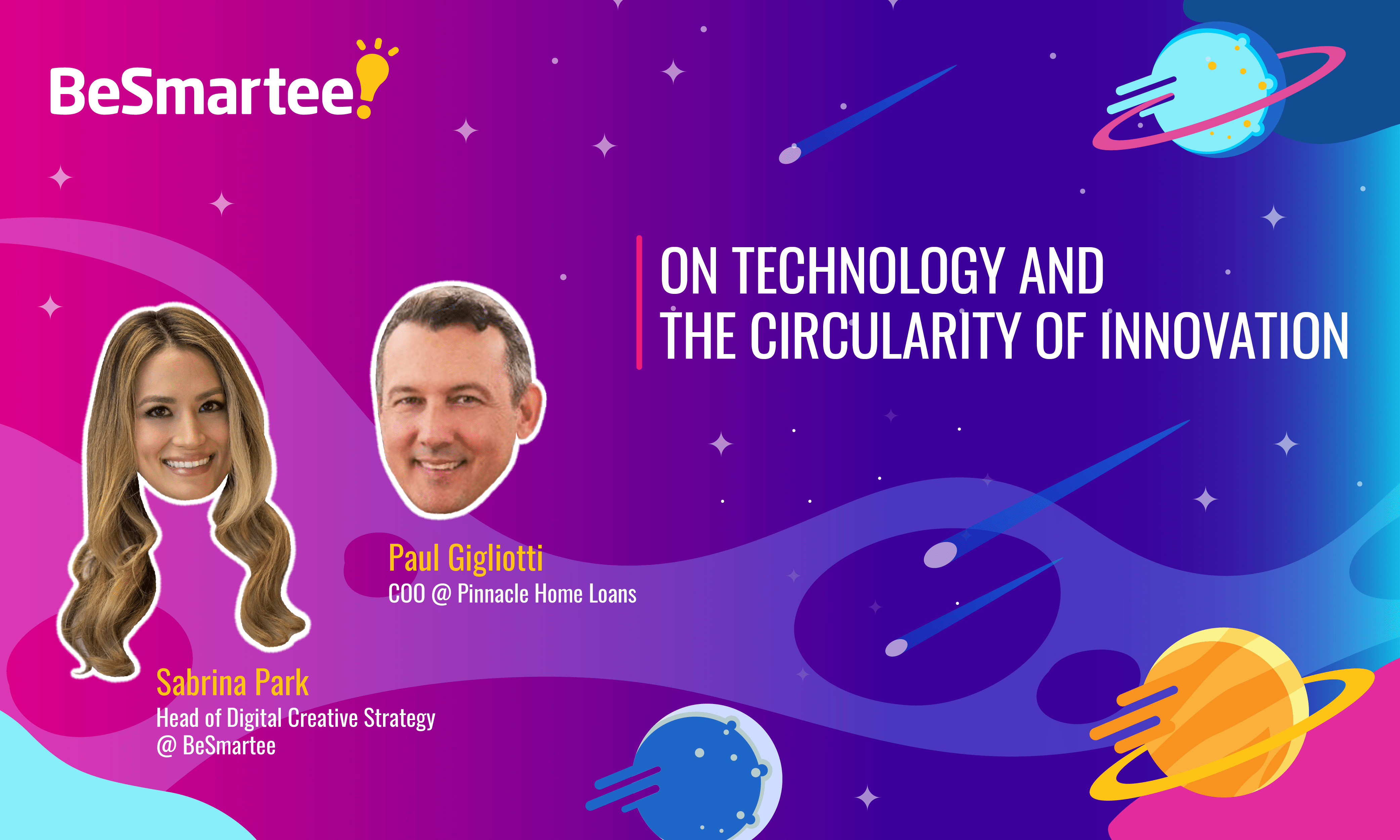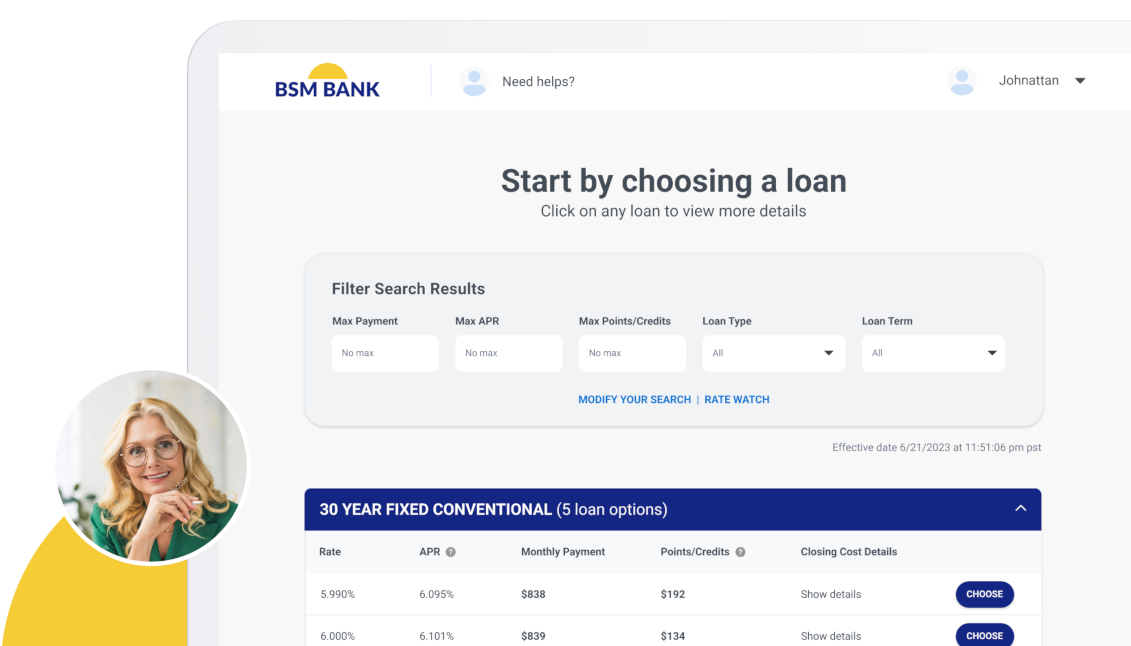Paul Gigliotti talks all things mortgage tech in this BeSmartee interview. Read on for the full transcript from the video chat on technology implementation strategies, training resources to improve adoption, the circularity of innovation, the future of lending and more.
SABRINA PARK: Hi everyone! Sabrina here from BeSmartee. I’m here with Paul Gigliotti, COO of Pinnacle Home Loans. Thanks for joining us today, Paul.
PAUL GIGLIOTTI: Yeah. Thank you.
SP: Awesome. So, we’re going to go ahead and get started here. I have some questions for you. I’ve been seeing a lot of things on LinkedIn—a lot of valuable information for the community, and I’d love for you to share a little bit more about it. So, let’s get started.
PG: Yes, looking forward to it.
SP: Awesome. Part of your role here involves helping the organization structure and streamline complex projects. With respect to new mortgage technologies, what’s your implementation strategy, starting with vetting vendors all the way to project oversight between parties.
PG: I’m going to speak to where I’m leaning more, or spending more of my time right now, which is in completing and finalizing our tech stack. I’m going to kind of gear that question toward that realm. I’ll start by saying, in developing your tech stack and researching what tech solution you want to start with, I think where you get a greater lift is in starting with innovation.
My implementation strategy and in looking at a new vendor—whether that vendor is technology driven or not, and most are—my strategy is to start with, again, innovation. With innovation, it’s really interesting to me that innovation is sometimes left out of the equation of technology. If you start with innovation, you have the ability to compile a team environment or a team effort, right? Because what you’re doing is, you’re sitting down and collaborating with your team or your department. And you’re talking about, it’s almost like: as things are now and as things should be.
If you have that conversation with the concept of let’s innovate this process and procedure, or let’s innovate this department. You sit down and you look at what that innovation looks like, and you talk through it with your team in a team environment, you then start to create a roadmap.
With that roadmap, you figure out where you are now and what needs to happen for you to get to your end goal. Then, you sit back, and that’s when I feel a company should start looking at technology.
In my current role, I’m so fortunate to work with operations, closing, secondary, finance, accounting, and HR payroll, technology.
You sit down and you have these conversations. And then, as you’re talking about innovation, you start to get this concept of almost a visionary, and it almost becomes something that’s very creative. And I talk to my team. I’ve even almost done this to the point where… we’re in an art class, guys. We have this canvas, it’s a blank. We can do anything we want, as long as we’re compliant. So, let’s do it. Let’s take this blank canvas and create, and that portion is the innovation.
It might sound geeky, but it actually becomes something that’s super fun because you take that innovation again and you start to mold this concept of team environment with that innovation. You start to mold a concept of, almost, cross-function understanding because you’re a tech stack that can bleed into multiple departments.
SP: Absolutely. I love that you involve the whole team. I think that’s really great. Everyone being a part of something and having some say… I think that just keeps everyone, you know, excited to work at a company, right?
PG: Yeah!
SP: So, on that note, talking about teams, you design training materials for your teams post-software implementation, what has been the most effective type of resource that you’ve created to ensure adoption across your entire team?
PG: You know, it’s really interesting that adoption is really tricky, right? I’m sure you see it all the time, where you are and you’ve seen it in your career. You know, it’s not even as it relates to the mortgage industry.
I don’t ever want to do the iron fist adoption. You know, this is the drop dead date or we’re over to the new technology, or, you know, it has to be this way because that’s not how I promote growth, you know?
What we’ve done and what I found to be most successful is, with the team technology implementation or an innovation implementation, we create a committee. I believe it’s really important to make sure that that committee—each member represents each department.
So, for our LOS committee, we had someone from our IT department, so they understood how it read with… I’m sorry for our POS, we had someone that understood the LOS technology. We had someone from operations, and I even brought someone in from accounting and finance.
So, we had this committee, and we sat down and we talked about, you know, you map out almost like a wireframe you use for a website. You map out… how does it look when it starts and what is the end? And then you toss in training, right? From that, then you start to develop a business plan.
The reason why I’m finding the business to be more and more interesting is because what I’ve actually done, for technology that’s facing our originators and our operations team within our branches, is we’ve taken that business plan and we’ve done a road show with the business plan. We go to each branch—now, virtually—and we talk about why we implemented this software solution. What can this software solution or this innovation do for you at your branch? How do you plan on using it? And, then, with that information, we kind of compile a by-branch situation. What I’ve found to be really interesting is then bringing back and doing another virtual meeting, with a representative from that solution. It helps them understand that this technology, or this software solution, or this innovation, was brought to them with them in mind—to support them, to better them.
Then, we take that business plan and we keep it in stone for them. What we can do with that business plan is go back three, four months later and say: “Are we hitting your target, your hopes and dreams of this innovation and technology that you wanted, that you wrote down in this business plan… are we doing it?”
It’s either a yes or no answer. And based on their answer, then we make modifications.
I think what’s also really important is going back to that kind of culture, where it’s really a team environment. On those road shows we take—I can’t call them roadshows anymore—right? We take the committee members, so again, that’s across all departments, to those meetings. It helps those committee members, and maybe the team members from the branches, to see how the solution will evolve and help their position. An LO will think to themselves, well, wait, this solution is not only helping me, but it’s also helping operations, or it’s also helping accounting. You start to build this… Hey, come on. Help me out. Let’s work on this together because it’s supporting both of us. I think we can all agree that most technology solutions out there affect and touch almost every department in a company, if you drill down deep enough. I think that that levels up what technology and innovation can do in a company.
SP: In a recent LinkedIn post, you wrote about the circularity of innovation, which was really interesting to me. So, if you can dive a little bit more into that—how this mindset has helped you grow your team and build Pinnacle Home Loans into this amazing company.
PG: Thank you for saying Pinnacle Home Loans is amazing. It’s a great place to work. I sat back and I kept on thinking, what is innovation? Why do we have it? Innovation is really growth. Innovation is learning. So, to me that’s constant, and for something to be constant, it needs continuous movement. When I look at innovation, there’s no stopping and beginning, it continues to grow. I’ll pause and say, that’s why your technology is so important that you pick a technology that is going to continue to grow. That’s not going to bail. Technology is this continuous circle and it has movement. Innovation is not a bus you get on and off, right? It’s a constant flow.
For folks in the Bay Area, I often equate technology or compare it to the Golden Gate Bridge. When they start painting the Golden Gate Bridge, and they finish, they take a hiatus for a month and then the same crew comes back and starts painting again.
They’ve further developed the molecules in the paint, they’ve further changed the chemistry of it. Maybe it’s more eco-friendly or whatever the case may be, but because of where it is, its height, and since it’s said to be a monumental of a kind, they want it to look nice. It’s continuously going through change, right?
Innovation is very much the same and I’m so deep and passionate about it. I could talk about it all day long and, you know, we brought up some points in our conversation just now about how important that continuous is. It’s very comparable to a parent-child relationship, where it’s ever-changing, it’s ever growing, but it’s always there, until, the end, which we don’t talk about. That’s what it needs to be.
Again, we’ve all seen companies, and maybe some of us have been part of companies, where the innovation has stopped. You look at those companies and they either are no longer around or they’ve been bought and sold because when innovation stops, growth stops.
SP: Right, or they have to go through this whole new onboarding of different products and services that are in demand or… with the times.
PG: Kind of like a rebirth, which hurts!
SP: Exactly. And it’s, yeah, it’s painful. It’s expensive. It’s a lot of things. Question about that, actually. So, if you were speaking to a lender, or somebody from a lender that didn’t have a certain technology, like let’s say a mortgage POS or something like that. What would you say to them to explain the benefits of a product, such as a mortgage POS?
PG: That’s a really good question. I’m going to take a step back for a second and talk about innovation first, then technology. If a company is missing one of those crux technologies, like a POS… I would say almost every mortgage company has a POS. If not, they’ve got some type of form of taking an application on the fly.
I think where my concept and my, my chat would go first is… let’s review companies that are still standing and how those companies have evolved. Now, our mortgage industry, our industry has over the past, let’s give it eight years, has done this dramatic movement with technology. This movement, from where I sit, has been amazing because what it’s allowing us to do is concentrate on relationships. My relationship with you, I can do that because we have technology that’s taking care of some stuff right now that I used to have to sit and work on. To the point of the POS again, we had mentioned before that one of the biggest things that the POS does is it allows us to create deeper relationships with our consumers and provides a great amount of organization to maybe not the most organized folks out there.
Subscribe to BeSmartee 's Digital Mortgage Blog to receive:
- Mortgage Industry Insights
- Security & Compliance Updates
- Q&A's Featuring Mortgage & Technology Experts
The technology movement in our industry is leveling up our industry to where, I feel, the rest of the world was. It’s leveling up our industry to what all consumers expect, and what all consumers require—especially, now, with the changes that are occurring worldwide because of this pandemic, which I’m sure will be gone soon. Very soon.
SP: Here’s hoping.
PG: Because I really want a manicure and pedicure, and a massage.
I think what it’s doing is it’s leveling to consumer expectation. I think what’s going to happen pretty soon is a consumer is going to look at a company that doesn’t have the ease of a POS, that doesn’t have the ease of an eClose or a hybrid close… The consumer is going to look at them and say, I almost don’t trust you because you’re not at the bar where everybody else is.
Here’s a crazy analogy. I don’t know why I just thought of this. I’m going to date myself a little bit, and I know I’m a lot older than you, but I remember when I was a kid and my parents would have cars, and not all cars would have automatic windows. You’re like, what are you talking about?
SP: No, no, no. I actually know that. I know this!
PG: That was a luxury! Some cars, most cars would have the crank window, right? If you’re advanced five years later, now, you can’t even find a car with a crank window, right? Because that was a natural evolution. That was a natural progression. The consumer required it. The consumer really wanted it. The consumer required it. And, then, the consumer demanded it.
We’re right on the teeter of the consumer demanding this technology, especially as it relates to how the consumer interacts and obtains that tangible good. You know, our consumers are demanding… How many times have you talked to someone during this pandemic and they’ve complained about purchasing a product that was delayed?
SP: Oh, yeah! I mean, I have. I’m thinking, how many days is it going to take to deliver my package?
PG: Right. Because we’re used to Prime being there the same day, or maybe the next day, and now we’re having to wait a week. Do you see what’s happening with the consumer experience of purchasing merchandise? It’s, again, right at that tipping point. They’re demanding it, not only to be able to go on Amazon.com, or Etsy, or wherever you shop, and find something that fits your exact need, in your color… But now, you’re getting to the point where, and I don’t mean you, but consumers are demanding it immediately, right? The consumer purchasing experience, it’s almost in line with the mortgage purchasing experience, with purchasing a mortgage loan.
Those are some of the analogies that I would give to an owner of the mortgage company that, let’s say, didn’t have a POS. Then, you probably need to sit down, if I was pitching them on a tech stack, my conversation would then move into ROI, which would take two seconds. The ROI, it’s not just material, but how are you going to recruit loan officers? How are you going to talk loan officers into working for you if you don’t have these technology solutions that 90% of the world has?
SP: I think, also, on that note, just as a younger consumer—Millennials and Gen Z-ers—a lot of people don’t have a full understanding of the mortgage process. So, a technology that basically walks you through it, not that a loan officer couldn’t do that, they absolutely could and do, but because we’re so used to doing things online and just having that accessibility—tool tips and things that guide you through. At the same time, you have the opportunity to speak with a loan officer, co-browse with them. There are so many neat tools that you can use, and that I think, you’re right, we have to meet the demands of the consumer.
What’s the future of lending look like to you?
PG: I think that’s going to be really interesting, I think we’re going to start concentrating on data more and more. I think consumers that come to mortgage companies that are not driven with a previous relationship, so a referral, or a previous client, or a referral partner… it might be a real estate agent, or a financial advisor, or insurance. I think the consumer is going to start coming to a client of a mortgage company, almost prequalified. I think there are some great solutions out there that are really moving towards… You landed on this landing page. We already know X, Y, and B about you. All we need to know is Z, and we can send you on your way.
I think we’re going to really start moving toward being a data-driven company. I think business channels are going to remain what they are. You’re going to have retail companies, you’re going to have brokers, you’re going to have NDC and correspondent. I think that, again, this pandemic is really helping people to understand that we can trim down some of the processes and procedures. We can make it a little easier.
How do we do that? eClosing solutions. You know, just that solution in itself really helps drive a quicker turn time for signing, funding, collateral getting to where it needs to go, interacting with the title company. I think because of the technology we’re going to be relationship-based in understanding the consumer’s needs and being able to provide them an array of products to fulfill it.
Something that I’ve started to notice in our industry, that’s been happening over maybe the past 10 years—and I’m sure it has to do with technology and I’m sure it has to do with the housing crisis that occurred—our industry more and more is reacting quicker to change. I think we’re starting to really understand that it’s about the consumer, it’s about the consumers needs and we’re changing with that. I’m very proud to see the leveling up in our industry and what’s been occurring.
The response time to the pandemic was amazing. It was really awesome to see our investors respond, our warehouse facilities respond, us as a company respond. And that’s just on the product delivery section. I’m not even talking about how quickly we reacted to shelter in place, the day before it was even called out. And how everybody was immediately able to work remote and, for the most part, still are. I’m seeing this industry that’s evolving very quickly. I do think it’s going to be a consumer-focused relationship.
SP: Absolutely. Ultimately that’s the end goal for any company, right? That your consumer is satisfied, that they’ll come back to you, that you have that retention, that they’ll think of you every time they need a loan.
You’ve spoken about all the change that the industry has gone through. What would you say is maybe the biggest change in the last 10 years?
PG: I think it relates to technology. Can we count how many times I’ve said technology and innovation?
But, I think technology is really playing this amazing role and it’s not because of the technology solution, but what I’m finding more and more are the people that I’m interacting with. As technology is coming into our industry so hot and heavy, we’re dealing with leaders that are running companies from different industries.
We’re dealing with leaders that came from networking companies. We’re dealing with leaders that came from hardware companies. We’re dealing with leaders that came from social media companies, branding companies, but that had this huge technology background, right? So, if we look at all the leaders from Blend, Roostify, Maxwell, LQB and Ellie Mae, the executive-level members of these companies are not necessarily just mortgage-driven. We’re starting to have a trickle of experience that’s coming into our industry.
From where I sit, I think that, in a nutshell, is the biggest change because that is helping us concentrate on the consumer. It’s about being a profitable company, but it’s not just about making money. It’s not just about providing loan docs and funding. It’s how we do it. It’s visionary based. It’s kind of that… I’ll go back to my concept of a blank canvas, and being creative because we’re getting an influx of different minds and different concepts that are coming into the industry now because of the technology movement.
I think it dribbles down to the whole experience of getting a mortgage, but the movement that I was talking about is affecting how mortgage companies are run.
So for the leaders of the mortgage companies, their fellow partner is someone that maybe worked at Dell, or maybe it’s someone that worked at a SaaS company. They’re saying to a mortgage leader… Hey, what do you think about obtaining data this way and providing the consumer this type of product, or this type of experience or journey?
SP: Gotcha. OK. So, it’s collaboration between different industries. I like that.
Well, that’s great. That’s all I have right now. Hopefully, we’ll be able to talk again soon, but where can people find you online, Paul?
PG: You know, I think the best way to find me is to hit me up on LinkedIn.
SP: That’s great. Wonderful speaking with you, Paul. Hopefully, we’ll do this again soon.
PG: Yeah, I hope so. Thank you so much. It was a pure joy. You were awesome.
SP: Thank you.
END OF INTERVIEW
Get updates from BeSmartee sent directly to your inbox! Subscribe to our newsletter here.




